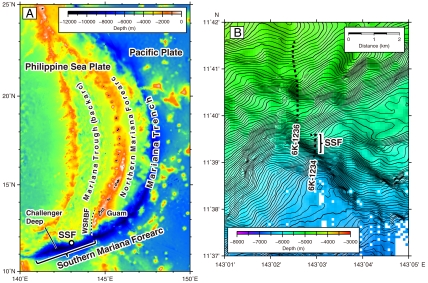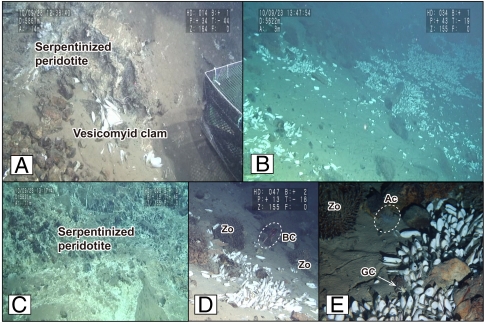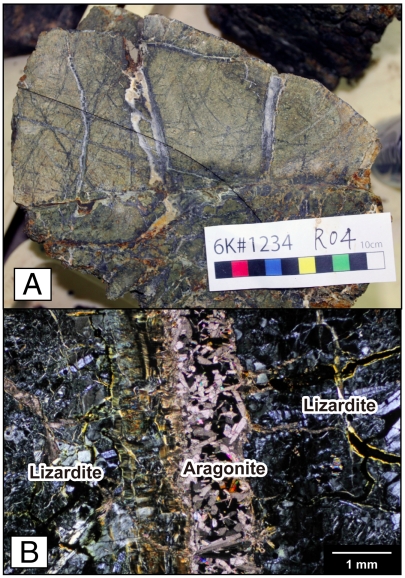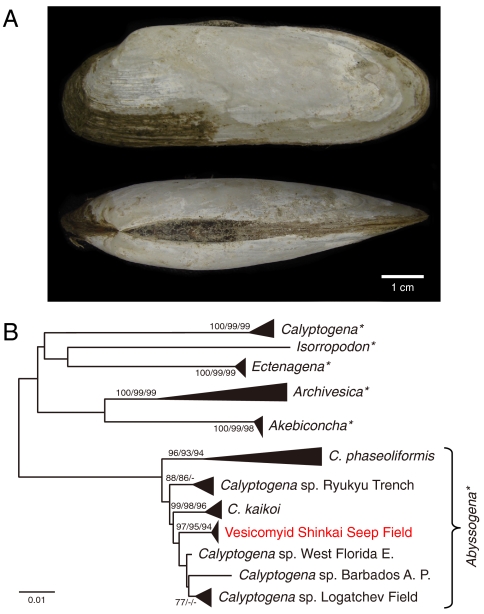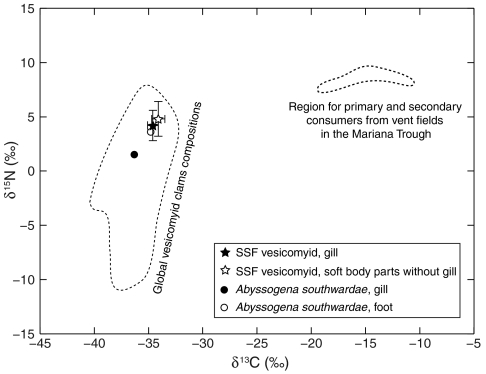Abstract
Several varieties of seafloor hydrothermal vents with widely varying fluid compositions and temperatures and vent communities occur in different tectonic settings. The discovery of the Lost City hydrothermal field in the Mid-Atlantic Ridge has stimulated interest in the role of serpentinization of peridotite in generating H2- and CH4-rich fluids and associated carbonate chimneys, as well as in the biological communities supported in highly reduced, alkaline environments. Abundant vesicomyid clam communities associated with a serpentinite-hosted hydrothermal vent system in the southern Mariana forearc were discovered during a DSV Shinkai 6500 dive in September 2010. We named this system the “Shinkai Seep Field (SSF).” The SSF appears to be a serpentinite-hosted ecosystem within a forearc (convergent margin) setting that is supported by fault-controlled fluid pathways connected to the decollement of the subducting slab. The discovery of the SSF supports the prediction that serpentinite-hosted vents may be widespread on the ocean floor. The discovery further indicates that these serpentinite-hosted low-temperature fluid vents can sustain high-biomass communities and has implications for the chemical budget of the oceans and the distribution of abyssal chemosynthetic life.
Keywords: Challenger Deep, convergent margin, hydrothermal vent, Shinkai Seep Field, vesicomyid clam
Hydrothermal activity plays an important role in Earth evolution by modifying the composition of oceanic crust, affecting ocean chemistry, forming metal-rich deposits, and providing energy and nutrient sources for chemosynthetic biological communities. Several varieties of seafloor hydrothermal vents with widely varying fluid compositions and temperatures occur in different tectonic settings. Along divergent plate margins, three basic vent types have been identified. The first type is a basalt-hosted, high-temperature hydrothermal system with fluid temperatures up to approximately 400 °C and low H2 and CH4 concentrations, but high metal concentrations (e.g., TAG hydrothermal field, 26°10′N Mid-Atlantic Ridge (MAR)) (1). The second type is a serpentinite and gabbro-hosted, high-temperature system with fluid temperatures up to approximately 360 °C and high H2, CH4, as well as high metal concentrations (e.g., Rainbow hydrothermal field, 36°14′N MAR; Logatchev hydrothermal field, 14°45′N MAR) (2, 3). The third type is a serpentinite-hosted, low-temperature system with 40 to 90 °C fluid temperatures and high H2, CH4, but low metal concentrations (e.g., Lost City hydrothermal field, 30°07′N MAR) (4, 5). There, carbonate chimneys are produced by highly reducing, high pH (9 to 11) vent fluids (4, 5). The third type may be fueled by exothermic serpentinization reactions (4). However, magmatic heat contributions to the third type are also suggested based on heat balance modeling (6), like the other two types that derive their heat from magmatic intrusions. The distinction of these three basic types at divergent plate margins can be linked to tectonic evolution of mid-ocean ridges, with fluid flow focusing along detachment faults to allow venting away from ridge axis (7). Along convergent margins, low-temperature hydrothermal systems with approximately 2 °C fluid temperatures associated with large serpentinite mud volcanoes in the Mariana forearc are well known (8–10). Serpentinite mud volcanoes erupt through interaction of fluids released from the subducting slab with faulted and/or mylonized peridotite formed along deep-seated faults in the lithosphere of the overriding plate (11), producing serpentinite, H2, CH4, and high pH (up to 12.5) fluids (12).
The discovery of the Lost City hydrothermal field has stimulated interest in the role of serpentinization of peridotite in generating H2- and CH4-rich fluids and associated carbonate chimneys, as well as in the biological communities supported in highly reduced, alkaline environments (4, 5). Serpentinization of peridotite produces H2-rich alkaline fluids, magnetite, and Fe-Ni alloys (13). Fischer-Tropsch-type reactions between H2 and CO2 using magnetite and Fe-Ni alloys as catalysts result in abiotic formation of CH4 (14). Anaerobic oxidation of CH4 generates H2S, which is the food source for the sulfide-oxidizing bacteria that are symbiotic with chemosynthetic biological communities. Such serpentinite-hosted systems may have played important roles in the emergence of life on the Earth (15).
In this article, we report the discovery of a serpentinite-hosted ecosystem in the southern Mariana forearc, named the “Shinkai Seep Field (SSF)” (Fig. 1A). This field was serendipitously found during the YK10-12 cruise of the R/V Yokosuka in September 2010, intended to study the geology of the southern Mariana forearc in detail. The field program included 8 dives with DSV Shinkai 6500 and 7 dives of the Yokosuka Deep-Tow Camera. The SSF was discovered during the DSV Shinkai 6500 dive 1234 (observer: T.I.), which was a lithological transect of the inner trench slope of the Mariana Trench along approximately 143°E. The location of the SSF is approximately 11°39.09′N and approximately 143°02.94′E, at depth of 5,861 to 5,550 m (Fig. 1 A and B) on a south-facing steep scarp of the inner trench slope of the Mariana Trench, approximately 80 km northeast of the Challenger Deep, Earth’s deepest location.
Fig. 1.
Location of the Shinkai Seep Field (SSF). (A) Bathymetry of the Mariana Trench and location of the SSF. The West Santa Rosa Bank Fault (WSRBF) divides the Mariana forearc into the southern and northern parts (marked by a dotted line). (B) Detailed bathymetry of the SSF area obtained during the YK10-12 cruise. Contours in 20 m intervals. The tracks of the DSV Shinkai 6500 dives 1234 and 1236 are shown by black dotted lines. Approximate location of the SSF is indicated. Dive 1236 recovered Eocene to Miocene subduction-related volcanics, not peridotites. The bathymetry in this area shows the absence of conical hills typical of serpentinite mud volcanoes common in the northern Mariana forearc.
Geologic Background
The Mariana arc-trench system is a nonaccretionary convergent plate margin where the mantle of the overriding Philippine Sea Plate interacts with fluids released by the subducting Pacific Plate. Subduction to form the Izu-Bonin-Mariana arc-trench system began at approximately 51 Ma (16, 17). Forearc is an important component of a convergent plate margin and is a broad region between the trench axis and the associated volcanic arc. Along the Mariana forearc southwest of Guam, the West Santa Rosa Bank Fault at approximately 144°15′E marks a major tectonic boundary (18), dividing the Mariana forearc into a stabler northern part and a southern part which is more tectonically active. The southern Mariana forearc is noted for facing the Challenger Deep (Fig. 1A). A number of serpentinite mud volcanoes exist in the northern Mariana forearc approximately 30 to approximately 100 km behind the trench axis 8–10), however none is known from the southern Mariana forearc. Instead, serpentinized peridotite crops out and has been sampled from the inner trench slope along the southern Mariana forearc (19, 20). The southern Mariana forearc is cut by numerous normal and strike-slip faults striking parallel and perpendicular to the trench axis, suggesting that the region is under north-south and east-west extension (18). Opening of the southern Mariana Trough (a backarc basin) and the presence of a short and narrow subducted slab west of the West Santa Rosa Bank Fault that is rolling back rapidly might be responsible for the different geologies of the two forearc parts (18, 21).
Dive Observations and Sample Descriptions
The DSV Shinkai 6500 dive 1234 observed close association of serpentinized peridotite and vesicomyid clams (Fig. 2 A–E), however, no active fluid venting was observed. Dive 1234 collected more than 30 live vesicomyid clams, along with peridotite, subordinate gabbro and a fragment of a white to ivory colored potential vent chimney (total 18 rocks, total weight approximately 77 kg), but no water samples because Shinkai 6500 was not prepared to do this. The lithologies encountered indicate that this section of the dive was on lithospheric mantle partially covered with locally derived debris flow deposits and ooze. Highly fractured outcrops of serpentinized peridotite were commonly observed during the dive (Fig. 2C). Fractures in the serpentinized peridotites and spaces between clasts in peridotite breccias commonly were filled with white minerals (Fig. 3A). Thin section observation (Fig. 3B) and X-ray diffraction (XRD) analyses confirm that the serpentine mineral is lizardite and the vein mineral is aragonite (CaCO3). These serpentinized peridotites include amphibole, like those from the dredge site approximately 50 km east of the SSF (20). Scanning electron microscope (SEM) observation and XRD analyses of the potential chimney fragment indicate that it consists mostly of brucite (Mg(OH)2) and acicular aragonite (Fig. 4 A and B). Brucite chimneys are also known in the Pacman Seamount (a serpentinite mud volcano) in the northern Mariana forearc (9), as well as in the Lost City field (4, 5, 22).
Fig. 2.
Field photographs taken during the DSV Shinkai 6500 dive 1234. (A) Live vesicomyid clams on fractured and cemented serpentinized peridotite. (B) Extensive vesicomyid clam community at 5,622 m depth. (C) An outcrop of fractured serpentinized peridotite filled with aragonite. (D) Close-up view of the vesicomyid clam community at 5,622 m depth, showing close association with zoanthids (Zo) and a Beroe comb jelly (BC; enclosed by a white dotted circle) with illuminated spots. (E) Close-up view of the vesicomyid clam community at 5,622 m depth, showing close association with zoanthids (Zo), an actiniarian (Ac; enclosed by a white dotted circle), and a galatheid crab (GC; pointed to by a white arrow).
Fig. 3.
Serpentinized peridotite recovered during the DSV Shinkai 6500 dive 1234. Veined serpentinized peridotite (sample #6K-1234-R04). (B) Photomicrograph showing the vein is primarily composed of aragonite (sample #6K-1234-R04). The host is now composed of lizardite. Crossed polars.
Fig. 4.
Potential chimney fragment recovered during the DSV Shinkai 6500 dive 1234. (A) Sectioned block of a potential chimney fragment (sample #6K-1234-R02) (B) SEM photomicrograph of a potential chimney fragment (sample #6K-1234-R02) showing the association of brucite (forming a lamellar texture) and aragonite (forming acicular crystals).
Abundant live vesicomyid clams were encountered between 5,861 and 5,550 m with the most extensive and diverse communities at 5,622 m at the base of an exposed section of serpentinized peridotite breccia (Fig. 2B). Vesicomyid clams host symbiotic bacteria within vacuoles in their gills. We know of no other descriptions of vesicomyid clams anywhere on the Mariana forearc, although Bathymodiolus mussel communities are known from the South Chamorro Seamount (a serpentinite mud volcano) in the northern Mariana forearc (23, 24). Although no active fluid venting was observed during dive 1234, the clustering of biological activity along the breccia horizon at 5,622 m suggests that the fluids responsible for nourishing the clams mainly vented along the base of this exposure, forming the most important SSF biological site. The organisms other than the vesicomyid clams viewed or collected at this field included actiniarians, zoanthids, a Beroe comb jelly, buccinid snails, and galatheid crabs (Fig. 2 D and E). No vesicomyid clam communities were found during a subsequent dive (dive 1236) on the slope above the end of dive 1234, which recovered Eocene to Miocene subduction-related volcanics (Fig. 1B). This observation clearly indicates that this community is hosted solely by serpentinized peridotite.
Shinkai Seep Field Vesicomyid Clams
On the basis of shell morphology, the vesicomyid clams are within the clade including the species assigned to genus Abyssogena proposed by Krylova et al. (25) (Fig. 5A). Based on partial DNA sequences (507 base pair) of mitochondrial DNA cytochrome oxidase c subunit I (COI) region, this species appears to be more closely related genetically to the vesicomyid clam described as Abyssogena southwardae by Krylova et al. (25) from the high-temperature serpentinite and gabbro-hosted Logatchev hydrothermal field (26, 27), and from the seep sites in the West Florida Escarpment and the Barbados Accretionary Prism (28) (Fig. 5B). Carbon and nitrogen isotopic compositions of soft tissues from the clams were obtained to determine the consumed food substrate and trophic level. The highly depleted δ13C values (-34.9 to -33.7‰) for the SSF vesicomyid clams are consistent with other vesicomyid clams with thiotrophic symbionts using dissolved CO2 from seawater and/or vent water as their carbon source (Fig. 6). The δ15N values (3.1 to 6.3‰) are similar to those of vesicomyid clams from other localities (Fig. 6). Although vesicomyid clams are among the dominant invertebrates of chemosynthesis-based communities found at hydrothermal vents, cold seeps, and whale carcasses, there have been no live examples from a serpentinite-hosted hydrothermal system including serpentinite mud volcanoes, except for the high-temperature serpentinite and gabbro-hosted system at Logatchev (26, 27) and the Vema Fracture Zone (although the hydrothermal activity in this location has yet to be documented) (25, 29). Fossil vesicomyid clams have however recently been reported from two sites near the high-temperature serpentinite and gabbro-hosted system at Rainbow (30, 31). It should be noted, however, that one of these sites, the Ghost City field, was not a high-temperature system when it was active approximately 110 kyr ago (31). The SSF vesicomyid clam community is therefore an important live example of a low-temperature serpentinite-hosted hydrothermal system from either convergent or divergent margins, extending our knowledge about the biogeography of these clams.
Fig. 5.
Phylogenetic analysis of vesicomyid clam from the SSF. (A) Specimen photograph (exterior of left valve and dorsal view). (B) Phylogenetic tree based on COI nucleotide sequences listed in Table S1. Bootstrap values (NJ/MP/ML) are shown beside nodes when the values are higher than 70. Scale bar represents 0.01 changes per nucleotide base. Operational taxonomic units (OTUs) with asterisk are expressed as the genus names proposed by Krylova and Sahling (36). OTUs without asterisk are expressed as the species names originally registered in the DNA Data Bank of Japan. All of these are assigned to genus Abyssogena proposed by Krylova and Sahling (36). Calyptogena sp. from Logatchev field, Barbados Accretionary Prism and West Florida Escarpment are now described as Abyssogena southwardae by Krylova et al. (25). A. P., Accretionary Prism. E., Escarpment.
Fig. 6.
Soft tissue stable isotopic analysis of vesicomyid clam from the SSF. δ13C and δ15N relationship for SSF vesicomyid clam. δ13C of gills (n = 3) and soft body parts without gill (n = 3) are -34.6 ± 0.5 (1 sigma) and -34.1 ± 0.6‰, respectively. δ15N of gills (n = 3) and soft body parts without gill (n = 3) are 4.2 ± 1.4 and 4.8 ± 1.6‰, respectively. Data for the vesicomyid clam described as Abyssogena southwardae by Krylova et al. (25) are shown for comparison (27). The global vesicomyid clam compositions are based on (39–45). Region for primary and secondary consumers from vent fields in the Mariana Trough (46) is shown to demonstrate the isotopic difference from vesicomyid clams.
Discussion
The serpentinization processes at several MAR hydrothermal sites are controlled by the interactions of seawater and peridotite with variable influence of magmatic heat (via gabbroic intrusions) (6). In contrast, the SSF is located in a deep inner trench slope of a convergent margin where magmatic heat contribution is unlikely. The serpentinization process at the SSF is instead likely controlled by persistent fluid flow from the subducting slab, although the bathymetry of the SSF indicates that it is not associated with a discernible serpentinite mud volcano (Fig. 1B). Fluids from Mariana serpentinite mud volcanoes have affinities with slab-derived fluids (32). The source of these fluids is dehydration of sediment and altered basalt at the top of the subducting Pacific Plate (12). The large volumes of slab-derived fluid available in a convergent margin setting appears to allow higher fluid-rock ratios than is possible in a mid-ocean ridge setting. Persistent fluid flow could eventually result in pervasive serpentinization of the peridotite beneath the SSF. It should be noted that the serpentinized peridotites from the SSF as well as from the dredge site approximately 50 km east of the SSF (20) include amphibole, suggesting a hydrous mantle beneath the forearc in this region.
The potential vent chimney sample from the SSF further constrains the origin of the SSF fluids. Systematic chemical variation of the fluids across the northern Mariana forearc is documented among the serpentinite mud volcanoes. The trench-proximal mud volcanoes (e.g., Pacman Seamount) have fluids with lower alkalinity and higher Ca, and brucite chimneys. In contrast, trench-distal mud volcanoes (e.g., South Chamorro Seamount) have fluids with higher alkalinity and lower Ca, and carbonate chimneys. This systematic variation reflects progressive devolatilization of the slab with increasing depth and temperature beneath the forearc (9, 12). The potential chimney sample from the SSF largely consists of brucite, consistent with the observation in the trench-proximal serpentinite mud volcanoes.
We thus interpret that the SSF represents a serpentinite-hosted ecosystem supported by fault-controlled fluid pathways connected to the decollement within a forearc (convergent margin) setting. Our DSV Shinkai 6500 diving and earlier dredging (19, 20) indicates that the deep geology of the southern Mariana forearc is dominated by peridotite and is heavily faulted, suggesting that more SSF-type seeps exist along the southern Mariana forearc, and perhaps, along the other nonaccretionary convergent margins like the Tonga forearc where extensive peridotite exposures in the deep forearc also are known (33). Our discovery supports the prediction that serpentinite-hosted vents may be widespread on the ocean floor (5, 30, 31). The discovery further indicates that these serpentinite-hosted low-temperature systems can sustain high-biomass communities. Therefore, this discovery could help us better understand how seafloor hydrothermal activity contributes to the chemical budget of the oceans and the distribution of abyssal chemosynthetic life.
Methods
SEM and XRD Analyses.
SEM observations of the potential chimney fragment were made at Southern Methodist University (Dallas, USA) on a Leo-Zeiss 1450VPSE electron microscope equipped with an EDAX Genesis 4000 XMS SYSTEM 60 energy-dispersive spectometer. XRD analyses of the chimney fragment were also made at Southern Methodist University with a Rigaku Ultima III XRD system. XRD analyses of the vein minerals of the fractured peridotite were made at Shizuoka University (Shizuoka, Japan) with a Rigaku RINT 2200 XRD system.
DNA Sequence Information for the SSF Vesicomyid Clams.
Phylogenetic relationships of the SSF vesicomyid clams were determined at Japan Agency for Marine-Earth Science and Techonolgy (JAMSTEC) based on partial DNA sequences (507 base pair) of mitochondrial DNA cytochrome oxidase c subunit I (COI) region, employing the method of Kojima et al. (34). The obtained sequences were aligned by CLUSTALW mounted in MEGA version 4 (35) with the sequences of the vesicomyid species which are proposed as type species of the five genera (Calyptogena, Ectenagena, Archivesica, Akebiconcha and Isorropodon) by Krylova and Sahling (36), as well as all the available sequences of genus Abyssogena in the DNA Data Bank of Japan (Table S1). Reconstruction of the phylogenetic tree was conducted by neighbor joining (NJ) (Kimura 2-parameter distance), maximum parsimony (MP), and maximum likelihood (ML) methods, using MEGA version 5.05 (37) (Fig. 5B).
Stable Carbon and Nitrogen Isotopic Compositions of the SSF Vesicomyid Clams.
Samples were prepared at JAMSTEC. The whole clam specimens were stored at -80 °C prior to dissection and isotope analyses. After thawing to room temperature, samples of gill and other soft tissues were dissected from the specimens, and were rinsed in filtered seawater. Prior to isotope analyses, samples were dried and powdered, and lipid was extracted following the method of Ohkouchi et al. (38). Carbon and nitrogen isotopic compositions were determined at the Japan Chemical Analysis Center with a Delta V advantage isotope ratio mass spectrometer coupled with an elemental analyzer via ConFlo IV interface. Analytical precisions observed by repeated measurements of authentic and laboratory standards were better than 0.2‰ for carbon and nitrogen. The results are expressed relative to Pee Dee Belemnite and atmospheric nitrogen standards in the usual notation (Fig. 6).
Supplementary Material
ACKNOWLEDGMENTS.
We thank the captain and crew of the R/V Yokosuka and the Shinkai team for the successful cruise. We also thank T. Okutani for helping us to identify the SSF vesicomyid clam. Thorough and constructive comments by two anonymous referees and the editor helped the authors to improve the paper. This study was supported by a grant for Izu-Bonin-Mariana arc study provided by the Institute for Research on Earth Evolution (IFREE), Japan Agency for Marine-Earth Science and Technology (JAMSTEC), as well as Japan Society for the Promotion of Science Grants C21540477 and A22244062, and National Science Foundation Grants EAR 0840862 and 1026150.
Footnotes
The authors declare no conflict of interest.
This article is a PNAS Direct Submission.
Data deposition: The sequences reported in this paper have been deposited in the DNA Data Bank of Japan, www.ddbj.nig.ac.jp (accession nos. AB629938, AB629939, and AB629940).
This article contains supporting information online at www.pnas.org/lookup/suppl/doi:10.1073/pnas.1112005109/-/DCSupplemental.
References
- 1.Humphris SE, Tivey MK. A synthesis of geological and geochemical investigations of the TAG Hydrothermal Field: insights into fluid flow and mixing processes in a hydrothermal system. In: Dilek Y, et al., editors. Ophiolites and Oceanic Crust: New Insights from Field Studies and the Ocean Drilling Program. Boulder, CO: Geol Soc of America Spec Paper 349; 2000. pp. 213–235. [Google Scholar]
- 2.Charlou JL, et al. Geochemistry of high H2 and CH4 vent fluids issuing from ultramafic rocks at the Rainbow hydrothermal field (36°14′N, MAR) Chem Geol. 2002;191:345–359. [Google Scholar]
- 3.Schmidt K, et al. Geochemistry of hydrothermal fluids from the ultramafic-hosted Logatchev hydrothermal field, 15°N on the Mid-Atlantic Ridge: temporal and spatial investigation. Chem Geol. 2007;242:1–21. [Google Scholar]
- 4.Kelley DS, et al. An off-axis hydrothermal vent field near the Mid-Atlantic Ridge at 30°N. Nature. 2001;412:145–149. doi: 10.1038/35084000. [DOI] [PubMed] [Google Scholar]
- 5.Kelley DS, et al. A serpentinite-hosted ecosystem: the Lost City hydrothermal field. Science. 2005;307:1428–1434. doi: 10.1126/science.1102556. [DOI] [PubMed] [Google Scholar]
- 6.Allen DE, Seyfried WE., Jr Serpentinization and heat generation: constraints from Lost City and Rainbow hydrothermal systems. Geochim Cosmochim Acta. 2004;68:1347–1354. [Google Scholar]
- 7.McCaig AM, et al. Oceanic detachment faults focus very large volumes of black smoker fluids. Geology. 2007;35:935–938. [Google Scholar]
- 8.Fryer P. Tectonic evolution of the Mariana convergent margin. Rev Geophys. 1996;34:89–125. [Google Scholar]
- 9.Fryer P, Wheat CG, Mottl MJ. Mariana blueschist mud volcanism: implications for conditions within the subduction zone. Geology. 1999;27:103–106. [Google Scholar]
- 10.Stern RJ, Fouch MJ, Klemperer SL. An overview of the Izu-Bonin-Mariana subduction factory. In: Eiler J, editor. Inside the Subduction Factory. Washington DC: AGU; 2003. pp. 175–222. (Geophysical Monograph Series, 138). [Google Scholar]
- 11.Fryer P, et al. Variability in serpentinite mudflow mechanisms and sources: ODP drilling results on Mariana forearc seamounts. Geochem Geophys Geosyst. 2006;7(Q08014) 10.1029/2005GC001201. [Google Scholar]
- 12.Mottl MJ, Wheat CG, Fryer P, Gharib J, Martin JB. Chemistry of springs across the Mariana forearc shows progressive devolatilization of the subducting plate. Geochim Cosmochim Acta. 2004;68:4915–4933. [Google Scholar]
- 13.Früh-Green GL, et al. Serpentinization of oceanic peridotites: implications for geochemical cycles and biological activity. In: Wilcock WSD, editor. The Subseafloor Biosphere at Mid-ocean Ridges. Washington DC: AGU; 2004. pp. 119–136. (Geophysical Monograph Series,144). [Google Scholar]
- 14.Holm NG, Charlou JL. Initial indications of abiotic formation of hydrocarbons in the Rainbow ultramafic hydrothermal system, Mid-Atlantic Ridge. Earth Planet Sci Lett. 2001;191:1–8. [Google Scholar]
- 15.Shock EL, Schulte MD. Organic synthesis during fluid mixing in hydrothermal systems. J Geophys Res. 1998;103(E12):28513–28527. [Google Scholar]
- 16.Reagan MK, et al. Fore-arc basalts and subduction initiation in the Izu-Bonin-Mariana system. Geochem Geophys Geosyst. 2010;11(Q03X12) doi: 10.1029/2018GC007731. 10.1029/2009GC002871. [DOI] [PMC free article] [PubMed] [Google Scholar]
- 17.Ishizuka O, et al. The timescales of subduction initiation and subsequent evolution of an oceanic island arc. Earth Planet Sci Lett. 2011;306:229–240. [Google Scholar]
- 18.Fryer P, et al. Why is the Challenger Deep so deep? Earth Planet Sci Lett. 2003;211:259–269. [Google Scholar]
- 19.Bloomer SH, Hawkins JW. Gabbroic and ultramafic rocks from the Mariana Trench: an island arc ophiolite. In: Hayes DE, editor. The Tectonic and Geologic Evolution of Southeast Asian Seas and Islands: Part 2. Washington DC: AGU; 1983. pp. 294–317. (Geophysical Monograph Series, 27). [Google Scholar]
- 20.Ohara Y, Ishii T. Peridotites from the southern Mariana forearc: Heterogeneous fluid supply in mantle wedge. Island Arc. 1998;7:541–558. [Google Scholar]
- 21.Gvirtzman Z, Stern RJ. Bathymetry of Mariana trench-arc system and formation of the Challenger Deep as a consequence of weak plate coupling. Tectonics. 2004;23(TC2011) 10.1029/2003TC001581. [Google Scholar]
- 22.Ludwig KA, et al. Formation and evolution of carbonate chimneys at the Lost City Hydrothermal Field. Geochim Cosmochim Acta. 2006;70:3625–3645. [Google Scholar]
- 23.Fryer P, Mottl MJ. “Shinkai 6500” investigations of a resurgent mud volcano on the Southeastern Mariana forearc. JAMSTEC J of Deep Sea Res. 1997;13:103–114. [Google Scholar]
- 24.Yamanaka T, et al. Stable isotope evidence for a putative endosymbiont-based lithotrophic Bathymodiolus sp mussel community atop a serpentine seamount. Geomicrobiol J. 2003;20:185–197. [Google Scholar]
- 25.Krylova EM, Sahling H, Janssen R. Abyssogena: a new genus of the family Vesicomyidae (Bivalvia) from deep-water vents and seeps. J Moll Stud. 2010;76:107–132. [Google Scholar]
- 26.Gebruk AV, Chevaldonné P, Shank T, Lutz RA, Vrijenhoek RC. Deep-sea hydro- thermal vent communities of the Logatchev area (14°45′N, Mid-Atlantic Ridge): Diverse biotopes and high biomass. J Mar Biol Assoc UK. 2000;80:383–393. [Google Scholar]
- 27.Sowthward EC, et al. Different energy sources for three symbiont-dependent bivalve moulluscs at the Logatchev hydrothermal site (Mid-Atlantic Ridge) J Mar Biol Assoc UK. 2001;81:655–661. [Google Scholar]
- 28.Peek AS, Gustafson RG, Lutz RA, Vrijenhoek RC. Evolutionary relationships of dee-sea hydrothermal vent and cold-water seep clams (Bivalvia: Vesicomyidae): Results from the mitochondrial cytochrome oxidase subunit I. Mar Biol. 1997;130:151–161. [Google Scholar]
- 29.Auzende J-M, et al. Direct observation of a section through slow-spreading oceanic crust. Nature. 1989;337:726–729. [Google Scholar]
- 30.Lartaud F, et al. Fossil clams from a serpentinite-hosted sedimented vent field near the active smoker comlex Rainbow MAR, 36°13′N: insight into the biogeography of vent fauna. Geochem Geophys Geosyst. 2010;11(Q0AE01) 10.1029/2010GC003079. [Google Scholar]
- 31.Lartaud F, et al. Fossil evidence for serpentinization fluids fueling chemosynthetic assemblages. Proc Natl Acad Sci USA. 2011;108:7698–7703. doi: 10.1073/pnas.1009383108. [DOI] [PMC free article] [PubMed] [Google Scholar]
- 32.Mottl MJ. Pore waters from serpentinite seamounts in the Mariana and Izu-Bonin forearcs, Leg 125: Evidence for volatiles from the subducting slab. Proc ODP Sci Results. 1992;125:373–385. [Google Scholar]
- 33.Bloomer SH, Fisher RL. Petrology and geochemistry of igneous rocks from the Tonga Trench: A non-accreting plate boundary. Jour Geol. 1987;95:469–495. [Google Scholar]
- 34.Kojima S, Fujikura K, Okutani T. Multiple trans-Pacific migrations of deep-sea vent/seep-endemic bivalves in the family Vesicomyidae. Mol Phylogen Evol. 2004;32:396–406. doi: 10.1016/j.ympev.2004.02.016. [DOI] [PubMed] [Google Scholar]
- 35.Tamura K, Dudley J, Nei M, Kumar S. MEGA4: Molecular Evolutionary Genetics Analysis (MEGA) software version 4.0. Mol Biol Evol. 2007;24:1596–1599. doi: 10.1093/molbev/msm092. [DOI] [PubMed] [Google Scholar]
- 36.Krylova EM, Sahling H. Vesicomyidae (Bivalvia): current taxonomy and distribution. PLoS ONE. 2010;5(4):e9957. doi: 10.1371/journal.pone.0009957. doi: 10.1371/journal.pone.0009957. [DOI] [PMC free article] [PubMed] [Google Scholar]
- 37.Tamura K, et al. MEGA5: Molecular Evolutionary Genetics Analysis using maximum likelihood, evolutionary distance, and maximum parsimony methods. Mol Biol Evol. 2011;28:2731–2739. doi: 10.1093/molbev/msr121. [DOI] [PMC free article] [PubMed] [Google Scholar]
- 38.Ohkouchi N, Kawamura K, Kawahata H, Taira A. Latitudinal distributions of terrestrial biomarkers in sediments from the Central Pacific. Geochim Cosmochim Acta. 1997;61:1911–1918. [Google Scholar]
- 39.Boulégue EL, et al. Geochemical and biogeochemical observations on the biological communities associated with fluid venting in Nankai Trough and Japan Trench subduction zones. Earth Planet Sci Lett. 1987;83:343–355. [Google Scholar]
- 40.Fisher CR, et al. Microhabitat variation in the hydrothermal vent mussel, Bathymodiolus thermophiles, at the Rose Garden vent on the Galapagos Rift. Deep Sea Res. 1988;35:1769–1791. [Google Scholar]
- 41.Kennicutt MS, II, et al. An upper slope “cold” seep community: Northern California. Limnol Oceanogr. 1989;34:635–640. [Google Scholar]
- 42.Saino T, Ohta S. 13C/12C and 15N/14N ratios of vesicomyid clams and a vestimentiferan tube worm in the subduction zone east of Japan. Palaeogeogr Palaeoclimatol Palaeoecol. 1989;71:169–178. [Google Scholar]
- 43.Kim ES, et al. Carbon, nitrogen and sulfur isotopic ratios in hydrothermal vent animals from the mid-Okinawa Trough. JAMSTECTR Deepsea Res. 1990;6:129–137. in Japanese with English abstract. [Google Scholar]
- 44.Rau GH, et al. δ13C, δ15N and δ18O of Calyptogena phaseoliformis (bivalve mollusc) from the Ascension Fan-Valley near Monterey, California. Deep Sea Res. 1990;37:1669–1676. [Google Scholar]
- 45.Fiala-Médioni A, et al. Source of energy sustaining the Calyptogena populations from deep trenches in subduction zones off Japan. Deep Sea Res Part I. 1993;40:1241–1258. [Google Scholar]
- 46.Van Dover CL. Trophic relationships among invertebrates at the Kairei hydrothermal vent field (Central Indian Ridge) Mar Bio. 2002;141:761–772. [Google Scholar]
Associated Data
This section collects any data citations, data availability statements, or supplementary materials included in this article.



